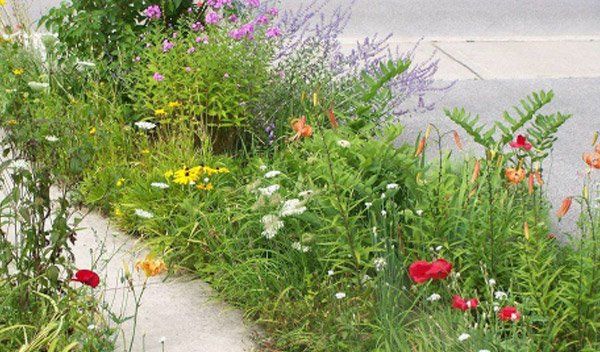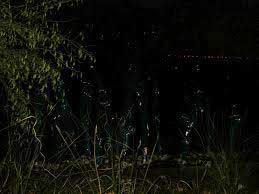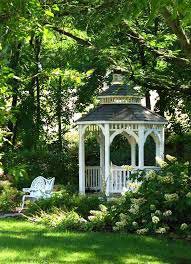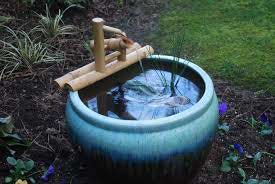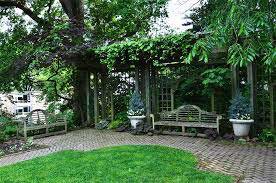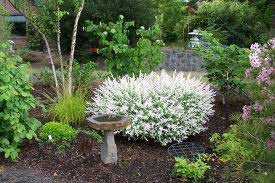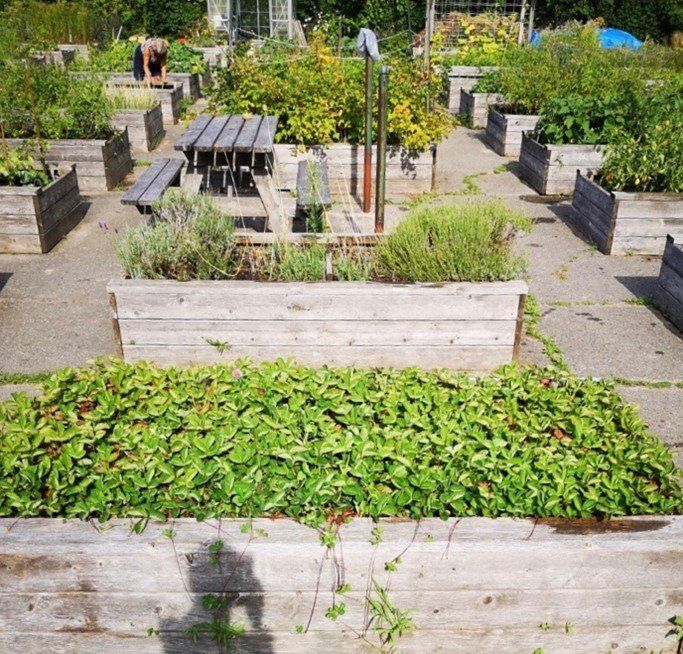A Night Garden
Does this sound familiar? It’s one of the hottest days of a long hot summer and, to make matters worse, you had to work late. You’re finally home, dinner is over and the clearing up is done. It’s time to take a cold drink and sit on the deck to enjoy the garden and cool off. You settle back in a comfortable chair and look around at ... absolutely nothing! Oh sure, you can see a couple of dark lumps of something that are probably flowering plants but that’s about it. What a disappointment!
Work schedules, sweltering summer days that keep us inside until the evening, entertaining outside: - these are all things that have increased our use of the garden at night; but many of our gardens aren’t designed to be at their best at night. If yours is one of these, maybe you should consider creating a night garden. Whether you decide to start from scratch and build a garden that is at its best at night, or if you would prefer to make changes to an existing garden to improve its appearance after the sun goes down, we hope this article will provide some ideas that will help you with your project.
Location, Location, Location: The first step in deciding on the best location for your new garden is to determine what its main use will be. Will you be doing a lot of entertaining, or does your family eat outside during the summer? If that’s the case a location that provides enough space for a group of people and that has easy access to the living room and kitchen/dining area makes sense. If you want an evening sanctuary to recover from your busy day, think of locating it outside the master bedroom, or even away from the house. Locating it near an existing seating area such as a veranda or deck, will make sure you can sit and enjoy your night garden.
Remember, views and vistas that you can’t see aren’t an asset in a night garden, and wide open spaces can feel threatening in the dark, so a natural enclosure or sheltered area in your yard might be the perfect spot.
Hardscaping: Hardscaping is a catch-all term that refers to everything in the garden other than the plants. Wherever possible, use light colours as they will reflect what light there is. As noted above, the night garden should have a seating area and, if it’s located away from the house, will benefit from some kind of shelter. A light coloured arbor or gazebo can provide this, and also act as a focal point. Speaking of focal points, like all gardens a night garden needs one or two. A light coloured statue, bird bath or a path of light coloured material will draw the eye into the garden. Or try a path constructed of dark material and edged with light. This can give the illusion of water running through the garden, and a garden at night should be a place of illusion and magic.
-
Safety Lighting
Photo By: John DoeButton -
"Downlighting" provides an over-all glow
Button -
Accent a focal point
Button
Let There be Light: But exercise restraint, you’re not lighting Versailles. The first consideration for light in the night garden is safety. No garden is enhanced by the sound of “Aunt Bessie’s in the pond again” ringing through the night. Pathways, steps and ponds need to be illuminated. The best way to do this is with a wash of light at ground level. You want to light the feature, not shine light into the eyes of someone approaching.
There are three types of decorative lighting that you will want in your night garden. The first is the normal decorative outdoor fixtures. This is the only type of lighting where the actual light source is easily visible, and includes outdoor lanterns, candles etc. This type of lighting should be limited to no more than around 25% of the decorative lighting in your garden. The next type of decorative lighting to consider is ambient light. The goal is to give an over-all glow to the garden, as if it were bathed in moonlight. This can be achieved by “downlighting”, a technique where the light source is located overhead with the light beam shining down and widening out.
“Uplighting” is an effective means of lighting focal points in your garden. The lighting source is located at the base of the object and gives a beam of light directly on the item you want to show off. Remember not to get carried away and have too many focal points in your garden!
You can also bring the illusion of light to the night garden by using reflective materials. Experiment with silvery metal finishes and consider using a mirror placed on a fence or screen.
Turn up the Volume: Sight is the primary sense engaged in the garden during the day; however, at night sight is limited, and the night garden must appeal to our other senses. Bring sound into the garden with a fountain or waterfall. It doesn’t have to be large and elaborate.
Wind is also a source of sound. There is a wide variety of wind chimes available, from those with deep rich tones to those with the sound of tinkling bells that will add interest to your night garden. Incorporate grasses and trees and shrubs in your plantings and hear them rustle in the evening breeze. A path made of pebbles will produce a crunching sound when walked on.
Can You Smell That? Smell is the most evocative of our senses. Have you ever smelled something that suddenly took you back to your childhood? The part of the brain that governs our sense of smell, the limbic system, is also responsible for memory. A night garden should be a fragrant garden. We’ll be talking about choosing plants for their fragrance as well as their appearance; however, there are other ways to bring fragrance into your garden. Fill containers with annuals that are fragrant at night and position them beside a bench at “nose height”. Plant fragrant herbs between patio stones, or use them to edge pathways. Use shredded cedar bark or pine needles to surface pathways or to mulch flowerbeds.
Planting the Night Garden: I’ll bet you thought we’d never get there! In general you’re going to be choosing plants with white or light coloured (pale pink, pale yellow) flowers. Light, silvery blues and lilacs can also work. If your garden is a sunny one during the day add some brighter colours, or you will find that it looks washed out in the bright light. Look for plants with variegated foliage, which gives the illusion of light dappling the leaves, or gray foliage that shines in the dark. Don’t forget to include plants for their fragrance, especially those that are fragrant at night.
If trees are part of your garden plan, those with white or silver bark, such as the Paper Bark Birch (Betula papyrifero) will provide a luminous background. The Yellowwood (Cladrastis lutea) has light silver grey bark, but the fragrant white wisteria-like blooms are its main feature.
Shrubs can be used to enclose the space, and make it feel safe and intimate. Consider one of the variegated dogwoods, such as Cornus kousa ‘Wolf Eyes’. Rosa rugosa ‘Blanc Double de Coubert’ may not have interesting foliage, but its fragrant white flowers are glorious. Keep deadheading and it will flower all summer.
The Moonflower (Ipomoea alba) is a vine that produces large white fragrant blooms that open at night, and is a must for the night garden. The Moonflower is an annual; however, if you prefer a perennial vine that returns reliably every year consider the Sweet Autumn Clematis (Clematis terniflora). The small, white star-shaped flowers are delicately scented. If you decide to grow this vine make sure you have a strong support for it, because it’s a big one!
There are a number of perennials and hardy bulbs that deserve a place in the night garden. One of the most fragrant is the Madonna Lily (Lilium candidum), that flowers in late spring/early summer. Unfortunately it is attractive to the red lily beetle, so you need to be vigilant, but it’s worth it for the wonderful scent. Try growing white or light coloured garden Phlox (Phlox paniculata). There are a lot to choose from. In addition to a long period of bloom and a delicate fragrance, they attract butterflies.
If your night garden is shady during the day, the White Bleeding Heart (Dicentra spectabilis ‘Alba’) will light it up both day and night with masses of white flowers in the spring. The only negative feature of this lovely plant is its disappearance when the heat of summer sets in. And can you ever have too many hostas? Their variegated foliage brings the illusion of light into the night garden.
Don’t forget about annuals. Old fashioned Nicotiana (Nicotiana sylvestris) is sweetly scented at night, but don’t be tempted by the many hybrids. They may be colourful but they don’t have that fragrance. Datura has white or pale, very fragrant flowers and could be a good choice for those containers flanking the bench. Be careful, it’s poisonous!
There are a number of more unusual tender bulbs that are fragrant at night and would also be suitable for those containers by the bench. Try Gladiolus callianthus (previously called Acidanthera) or Spider Lily (Hymenocallis festalis) and breathe deeply.
If you would like a comprehensive list of plants for the night garden, please e-mail us at
Latest Blog Posts
